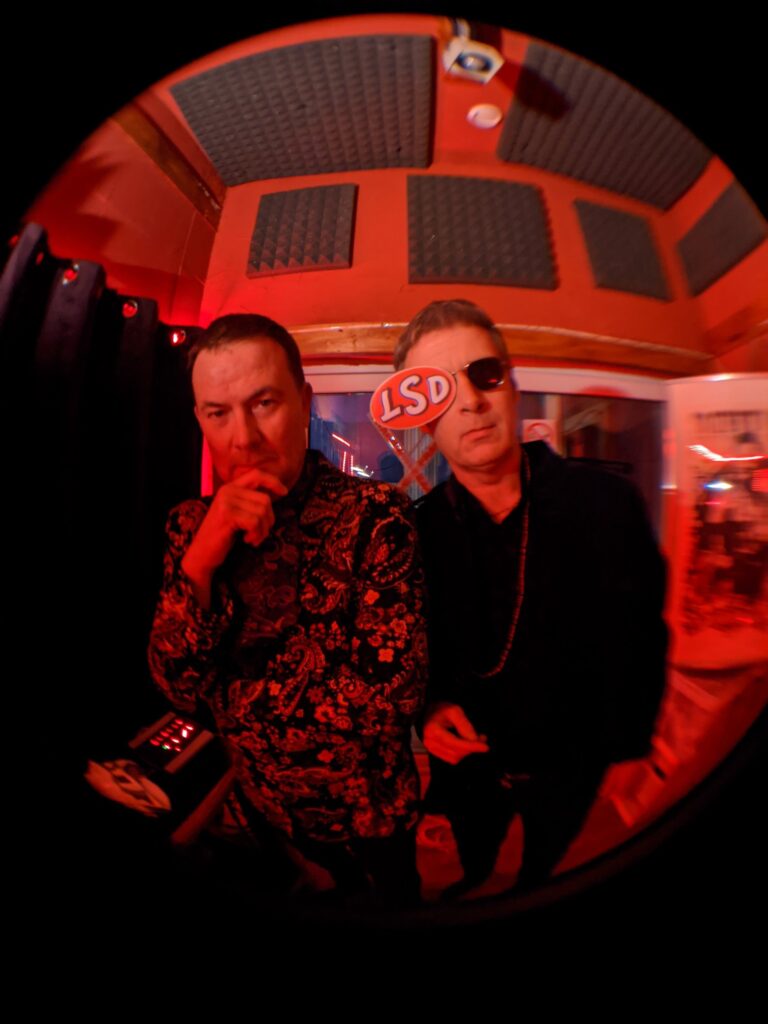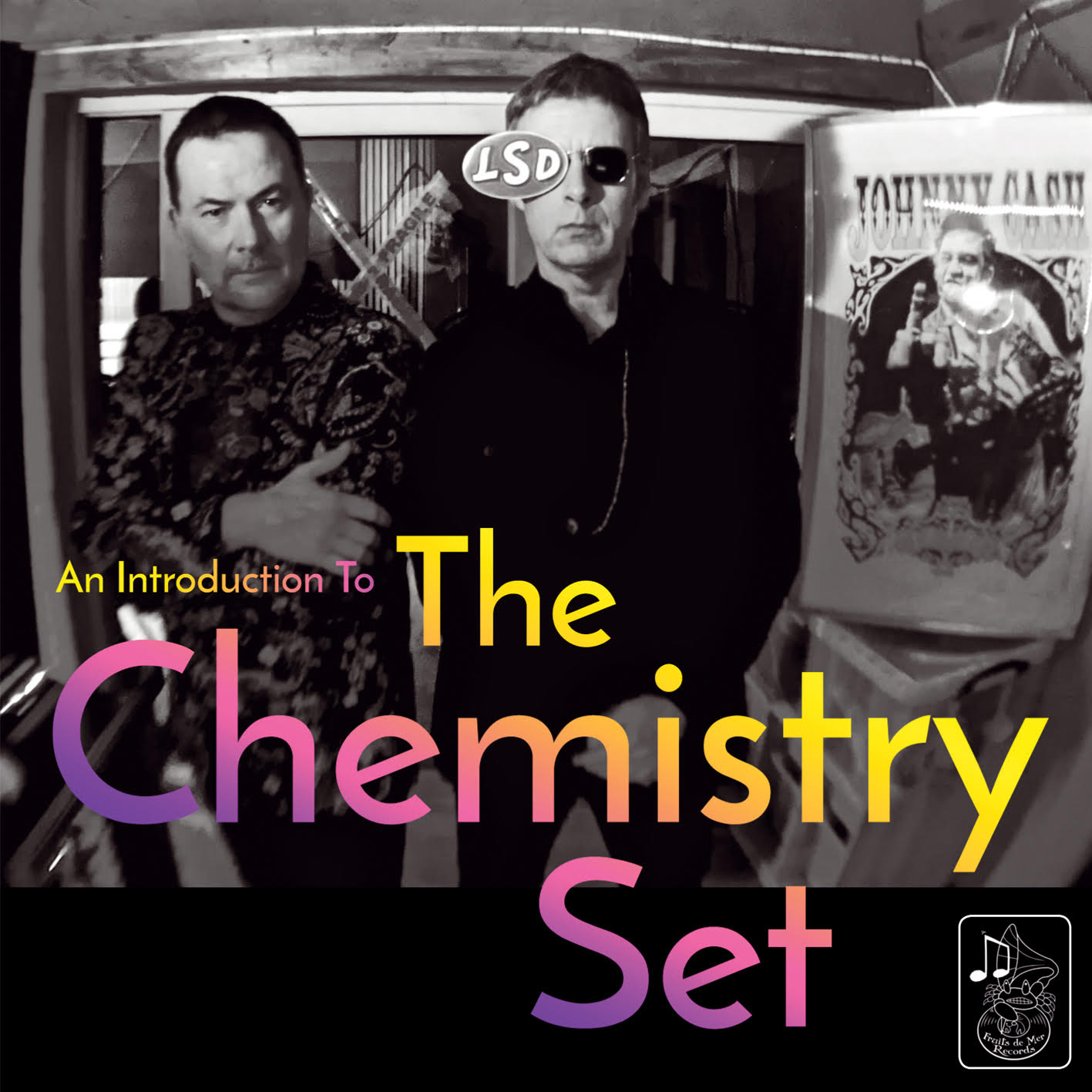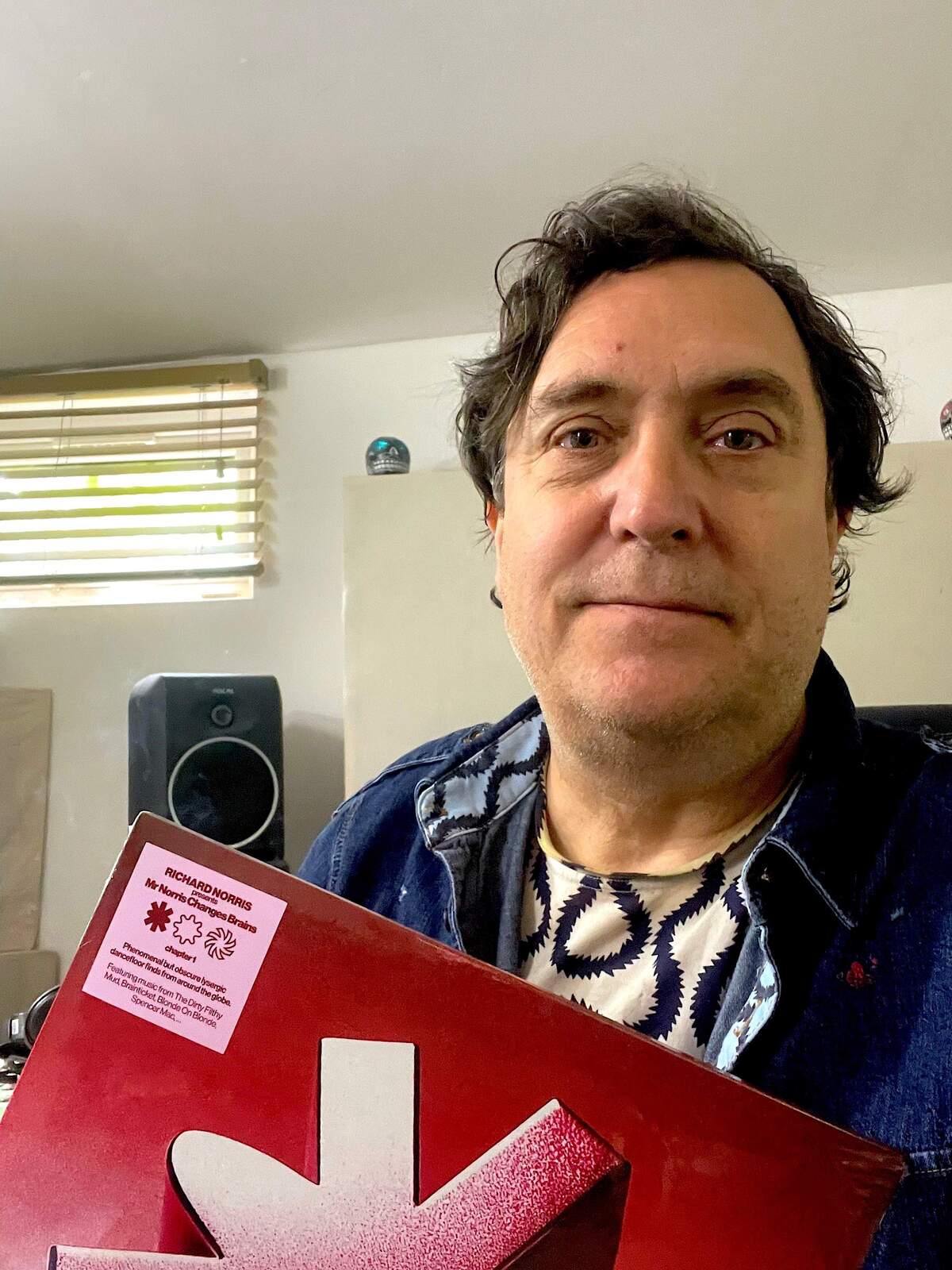Track by Track with The Chemistry Set
‘An Introduction to The Chemistry Set’ is a double CD, 37 years in the making. Paul Lake and David McLean reunite with Fruits de Mer Records for a two-and-a-half-hour, handpicked dive into their remastered psychedelic back catalogue.
It’s a career-spanning trip from two sonic alchemists who never stopped exploring. Some bands burn bright and vanish. Others simmer underground, casting spells the world slowly wakes up to. The Chemistry Set belong firmly in the second camp. Formed in late-80s London, Paul Lake and David McLean emerged from a haze of paisley shirts, fuzz pedals and wild ambition, conjuring neo-psychedelia when the charts were more interested in shoulder pads than sitars.
Their early days were a blur of gigs at Camden haunts like the Falcon and The Mean Fiddler, backed by tapes on Acid Tapes and releases via Manchester’s Imaginary label. Before long, they were touring Europe with the likes of Robyn Hitchcock and Bevis Frond, building a global cult following through pre-internet word of mouth. If you were a teenage psych head in Tokyo in 1991, chances are you had a Chemistry Set flexi-disc in your collection. John Peel played them. Clint Boon raved about them. Even Tony Wilson tapped them for his TV show.
Then, silence. Life intervened. But in 2008, after a chance reunion in a Morrison’s car park, Lake and McLean regrouped and began crafting a second chapter. They recorded new material at their Thames island studio, complete with vintage Mellotrons and a keen ear for sonic detail. Their 2009 comeback ‘Alchemy#101’ was a rich, swirling return to form, drawing praise from BBC 6 Music and XFM alike.
Since then, they’ve released dozens of records, each lovingly packaged and frequently sold out before the ink dried. Now, ‘An Introduction to The Chemistry Set’ on Fruits de Mer Records brings their legacy into sharp, prismatic focus.
As the band says, this is a love letter to the fans who’ve stuck with them, and an invitation to those just tuning in.
In the following interview Dave and Paul delve into their favourite tracks, discussed in typically thorough detail, from their recent career retrospective, ‘An Introduction to The Chemistry Set,’ released on Fruits de Mer Records.
Paul’s Favourite Songs
‘Crawling Back To You’ (From ‘The Endless More And More’ LP)
Paul: Both my grandmothers owned pianos to provide home entertainment back in the days before TV ownership was widespread, and a singsong around the “Old Joanna” with a few drinks was a social event.
My paternal grandmother, despite years spent working in a factory in London, enjoying a good drink and smoking filter-less Woodbine cigarettes for most of her life, somehow managed to reach the age of 92. Upon her passing, I inherited her Yamaha piano on which she would knock out Mrs Mills type tunes. Unfortunately, we did not have room to keep it in the house, so after years standing in the garage, I eventually donated it to a local residential care home.
However, before I parted company with it, I managed to get it to the recording studio and use it to record ‘Crawling Back To You,’ a song that I had written on it in the garage to the annoyance of my neighbours. I’m no Bobby Crush, but I couldn’t resist having a go at creating a bit of a knees-up melody to which I added slide guitar and even a ukulele part in the middle eight.
The lyrics reflect the outlook of some of the characters I grew up knowing in the Working Man’s Club/CIU that my dad used to regularly drink in and where I would accompany him from an early age, near to where we lived in South East London.
The character in the song has become a bit of a work-shy waster after years of unfulfilled dreams and ambition have left him relying on drink and gambling to make his day more bearable. This attitude was not really that of the club regulars, who were very hard-working, surviving week to week. However, there was a kind of resignation back in those days that it was hard to break the mould and pursue a different way of life – owning your own home was a major achievement – as most people had been brought up in council flats and many stayed in them.
There was always a live band playing in the club on Friday and Saturday nights that had a major influence on me as I would watch them intently performing the oldies and occasionally the hits of the day like ‘Tiger Feet’. This was back in the 70s when velvet flares and frilly-fronted shirts were de rigueur for the performing acts.
Dave’s “social club” drum phrasing perfectly complements the style of the song which some reviewers have suggested must be influenced by The Kinks or the white album Beatles period. In fact, it is probably more redolent of a track from an LP that I grew up listening to at home as a kid: ‘Crippled Inside’ from John Lennon’s Imagine. I didn’t deliberately go out to sound like this but after the song was finished, I realised there was certainly a nod to this song going on here. I guess whether the influence is old Music Halls or Working Men’s Clubs, it all boils down to getting around the piano and having a good old knees-up.
‘Love or Confusion’ (B-side of ‘Elapsed Memories’ single)
Paul: After the break-up of the original band in the early 90s, I occasionally performed on my own in folk clubs playing my 12-string acoustic.
Since my early teens I had idolised Jimi Hendrix and one of the songs I used to perform was his ‘Love or Confusion’ in an open G tuning with the B string also dropped down to a G to give it a raga feel.
Years later I thought that this would be a great song for us to cover and so decided to go the whole folky Indian-influenced way by also playing my sitar (which I had bought when honeymooning in India back in 1997). The sitar parts sit in the gaps and act as a kind of response to the faithful old 12-string licks before Dave adds a highly imaginative crazy flute mellotron with backwards parts over a steady tabla drum rhythm track.
Interestingly, our version of the song got a mention in the US edition of Rolling Stone magazine, which was highly unexpected!
‘Psychotronic Man’ (From ‘Pink Felt Trip’ LP)
Paul: Back in 1988, the year after the recording of a home demo tape on a hired 4-track Fostex recorder by some obscure band of psychedelia-obsessed lads from South London, a guy in Calne, Wiltshire, named Steve Lines, picked up on the recording and released it on his cassette-based Acid Tapes label.
It became the first release of any kind by The Chemistry Set. From then on, he continued to support the band relentlessly. Our first gig outside London was organised by Steve in his hometown, supported by his own band, Stormclouds. That night he presented us with a fantastic stage backdrop cloth banner that he had designed: a butterfly logo of the band’s name (that was afterwards dragged around and pinned up at hundreds of gigs and became the band’s trademark).
He then went on to produce the wonderful artwork for our first vinyl album release in 1989, Wake Up Sometimes. In addition, Steve and his good mate Clive Jones travelled all the way up from the South West to watch us perform many of our gigs in London.
It was therefore a great shock when, in 2021, Dave informed me that Steve had succumbed to complications from COVID. I was profoundly shocked and saddened by this news. Regretfully I hardly knew Steve and hadn’t seen him for years, but he was such an important part of our early development and so loyal to the fledgling young band that I had to write a tribute to this immensely gifted artist, poet, storyteller and musician.
Using the titles of some of Steve’s incredibly brilliant illustrations and publications as the lyrics, I formed the basis of a science-fiction themed song with Middle Eastern overtones, knowing that Steve had used ancient Egypt as a subject for some of his work.
Dave and I had purchased a Persian setar from an Iraqi guy in London who had originally bought it in Baghdad, so I thought I would put it to use on this song, along with my old 12-string acoustic. I used a violin bass to add a woody tone as I wanted to keep the song as organically acoustic-based as possible. Using the wonders of modern technology I was able to also play some runs of eastern sounding notes on my guitar and turn them into a Qanun (Egyptian zither) as well as a Persian Ney (flute).
In reverence of Steve’s band Stormclouds, I devised a short middle section that was intended to be a pastiche of a 60s British sci-fi series based upon one of Steve’s works, ‘The Doctor’s Pond’. I play the role of the professor while my daughter, Hannah, provides the voice of his assistant as they try to escape from the manic monster that emerges from the pond, voiced by Dave. Interestingly, some reviewers thought that we had sampled this from an actual TV show, which I thought was fantastic!
The title of the song was chosen in celebration of Steve’s nom de plume, “Psychotronic Steve,” and through his old friend Clive Jones, a video was produced on YouTube for the song featuring Steve’s original black and white illustrations colourised by his son Matt.
I am very honoured and deeply touched to know that Steve’s family loved the song and thought it was a fitting tribute to this brilliantly talented and caring man.
Dave and Paul’s Joint Favourite ‘Song on Introduction to The Chemistry Set’
‘The Witch’ (B-side of ‘Paint Me A Dream’ single and ‘Pink Felt Trip’ LP)
Paul: I must confess, perhaps rather sheepishly, that I’d never heard of this song before, until Dave suggested we do a cover of it.
I had a good listen and was surprised when Dave said I should have a crack at singing the lead as whoever chooses to record a particular cover version normally sings it.
At the time I had been reappraising The Red Crayola/Krayola and so thought maybe we could keep the main guitar riff of the original but gradually build it up into something monumentally noisy in the style of the free form freak-outs of ‘Parable of Arable Land’ but a little more melodic while at the same time introducing a dark and sinister ambiance, in keeping with the witch storyline and the potential it held for not-yet-realised events that could unfold once she gains entry to the house via the window.
Fortunately, Dave was thinking along the same lines but with some very innovative additions. For example, being in possession of a magnificent baritone monasterial voice, he suggested we nick the monk piece from The Bee Gees’ ‘Every Christian Lion Hearted Man Will Show You’ to prelude the song with a Gregorian medieval chant.
Then he decided to replace the sitar riff of the Fry version with soft flute mellotron phrases, seducing the listener into a false sense of mellowness, unaware of what will unfold later.
As the song progresses, I employ some Syd-like slide guitar while Dave introduces a heavy riff on his Fender Esquire mirroring the ‘Through The Window’ phrase of the vocal melody that drifts in and out throughout the rest of the song before he adds an Eastern European Romany style Farfisa lick that imagines the witch dancing in the moonlight.
Then my Persian setar kicks in with a riff reminiscent of ‘Hurricane Fighter Plane’ and we both start to dig in with lots of percussive effects including me hitting a half-full whisky bottle with a knife I found in the studio’s kitchen.
I personally think this is the best cover version we have achieved to date and the Mark Swordfish remix is the best reinterpretation of one of our songs yet. It’s very flattering and humbling that someone would take the time to reimagine one of our songs as he has done. And what a fantastic job he did of it too.
Dave: This is mine and Paul’s favourite cover. In fact, it is a cover song with other cover songs hidden inside. It begins with the Gregorian chants from The Bee Gees’ 1967 ‘Every Lion Hearted Man Will Show You’ and starts very lightly with acoustic guitars and Paul’s voice but layer by layer the music gets stronger and weirder until you are finally in a free form freak out. If you listen closely, you can hear the riff from Pink Floyd’s ‘Candy and a Currant Bun’ and a riff from our favourite band (The Red Krayola’s) ‘Pink Stainless Tail’.
Paul also manically hits a half-full whiskey bottle in homage to The Crayola. I think this is the cover song we have deconstructed the most and were able to add originality and a nod and a wink to some of our influences.
I am really pleased with the drums on ‘The Witch’. On the intro I use the floor tom, playing a tribal rhythm, a kind of precursor of what is to come, and what comes is sheer freak out and the drums respond accordingly. I was also pleased with the use of the Mellotron on The Bee Gees intro and the flute sections. I also used a Farfisa with Middle Eastern phrases in the freak out section. This song was a total joy to record.
Dave’s Favourite Songs
‘Cesar Manrique – First Part of Self-Expression Trinity’ (‘Pink Felt Trip’ LP)
Dave: I have always been inspired by powerful symphonic sounds and in this song I was finally able to make my own pocket symphony.
The song was inspired by three things. The first was a classical concert I attended at the National Auditorium in Madrid. The composer was a young woman from Lanzarote (one of the Spanish Canary Islands), and she composed a piece that was utterly inspirational. There was a passage where the timpani drums were at the forefront and that stayed in my mind for months afterwards.
The second inspiration was the man of the song-title, Cesar Manrique, a Spanish artist, sculptor and passionate environmentalist. Manrique was born in Lanzarote but moved to Madrid and New York but returned home in 1966.
He was appalled by the plans for building concrete monstrosities (hotels) during the early boom of tourism in the 1960s.
He petitioned the politicians and islanders and won them over with his passionate ideas for sustainable development and crucially, architecture that blended in with the beautiful landscapes. The landscape is often compared to the planet Mars, due to its red earth and huge volcanoes. The European Space Agency chose Lanzarote as a perfect training ground for future missions to Mars, as the conditions are very similar to Mars.
Manrique managed not only to build beautiful sustainable architecture that blended in with the landscapes but also convinced the politicians not to build concrete monstrosities for tourism.
My third inspiration was the island itself. It is unlike any other place in our world, with wild barren open spaces and huge summits at the peaks of the volcanoes where you can literally see for miles and miles.
When I returned from the island, I had most of the melodies in my head and used a Mellotron to create the song. Normally I use a guitar for writing a song but the symphonic, passionate sounds I desired were best suited to a Mellotron. When we got into the studio, I added a whole suite full of mellotrons (flutes, cellos, violins, three strings, male choir). I also added the timpani that first inspired me in the classical concert and a tremolo guitar. Paul came up with a genius bass line and within days we had produced the pocket symphony that I had envisaged.

‘Pink Felt Trip’ (‘Pink Felt Trip’ LP)
Dave: Paul and I have been inspired for years by Captain Beefheart and Frank Zappa and wanted to write a song paying homage and utilising some of their unique styles. We wrote the song together during lockdown and the song kind of took its own direction once we came up with the intro.
We wanted to make the song very heavy and you can hear a lot of acid punk guitars and a ton of fuzz, including a fuzz bass and mega heavy drums. The lyrics are a kind of scat-surrealism: ‘Here it comes, it just ate Air Force One’, ‘Here it comes, bullets can’t kill it, dogs can’t bite it’.
I think it’s a unique song when you compare it to our other songs and a style we want to do again. It was a real blast to do. The lyrics and vocals were fun and I could even do an Elvis impersonation. The “doo-wop” part at the end was Paul’s homage to Zappa’s ‘Freak Out’ album: ‘We Live As We Dream… Alone’ (‘This Day Will Never Happen Again,’ CD).
I wanted to make an acoustic song in the style of Arthur Lee but it ended up being much more English and maybe more Nick Drake in style. The title comes from Joseph Conrad’s book ‘Heart of Darkness’ that was the inspiration for the film Apocalypse Now. I didn’t know at the time that the English New Wave group Gang of Four had also used this title. I have no idea if it was inspired by Conrad but it was a strange coincidence.
The song begins with solitude and searching. I used the backdrop of the coast of Cadaques (Catalonia) for the solitude. Cadaques was a fishing village where Salvador Dali lived and Aldous Huxley visited, as they were attracted to the unique blue skies and light. Paul plays a delightful acoustic 12-string lead break and inspired by Neil Young’s melancholy guitar and melodies from ‘After the Gold Rush’ the second part of the song returns triumphant with love in our heart. The producer, Manel Ibanez, added some touching mellotron passages and finished with a mellotron male choir. It is a very bare and naked song.
The Chemistry Set Facebook / Bandcamp / YouTube
Fruits de Mer Records Official Website / Facebook / Instagram / Twitter




